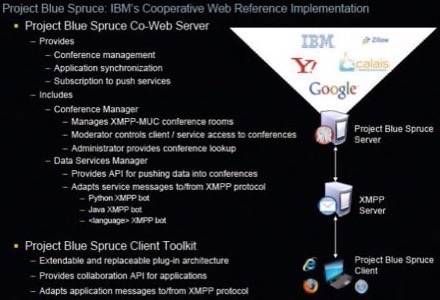IBM is about to commit itself heavily to browser-based applications. The giant IT company is quietly working on a project called Blue Spruce, which aims to create a fully browser-based application development platform. ReadWriteWeb was given an exclusive first look at Blue Spruce. Last week at Web 2.0 Summit we sat down with IBM’s VP of Emerging Internet Technologies, Rod Smith, for a “show and tell” of what IBM claims will be the next evolution of the browser. What’s more, it’s fully open standards based – so it is squarely aimed at challenging the proprietary rich internet platforms of Microsoft’s Silverlight and Adobe’s Flash.

Blue Spruce is a project within IBM that is only about 5 months old. Up till now it hasn’t been shown publicly. Blue Spruce isn’t yet complete, but conceptually it is two different things:
- Project Blue Spruce Client Toolkit
- Project Blue Spruce Co-Web Server

Here’s a summary of what we know so far about the Blue Spruce platform:
– Uses the WebKit Open Source Browser Engine (in the demo we saw, Safari was the browser being used)
– Uses the following Open standards: HTML, JavaScript, CSS, (All Ajax), XMPP, H.264
– Server runs on Linux, MacOS X
– Utilized OpenAjax Metadata Specification, so it can utilize any widgets
– It’s being ported to IE 6+ and Firefox
NOT a Web Browser, But is a Platform
To be clear, IBM is not developing another browser. The client part of this project is based on a set of browser-based open standards technologies. They will in time (2010 timeframe) be integrated into existing browsers such as Safari, Firefox and IE.
The grand plan for IBM, we think, is that it wants the browser to become the platform for applications – thus putting pressure on companies like Microsoft and Adobe, which still rely heavily on desktop applications (albeit these days connected to the Web).
It’s also worth noting that this isn’t (yet) an open source project. Rod Smith described it to us as a “community-sourced” project, meaning that it’s built on open standards and so others in the developer community can contribute. Smith said it “may” become an open source project in future, but it’s too early to say.
Why is IBM Heading to the Browser?
We asked IBM VP of Emerging Internet Technologies Rod Smith why IBM is moving to browser-based applications. He replied that customers have been consistently telling them for 1-1.5 years now that they don’t want to do installs anymore. Their customers want the rich experience that desktop apps have traditionally provided, but they want to have it in the browser. Collaboration and sharing data is also a trend that IBM is tapping into with Blue Spruce.

Proof of Concept Applications
At this time, Blue Spruce is in a closed beta period. IBM is creating applications for a number of customers, including Reuters and hospitals in Boston and New Zealand. They’re focusing on 3 main areas right now: finance, health and “heavy industry” (defined as utilities, rail, steel, etc). As the project matures, we can expect to see IBM stepping up its application development efforts – services is after all a key part of IBM’s business.
ReadWriteWeb was shown a number of ‘proof of concept’ demos. The functionality included Ajax-based mashups being used simultaneously by users in different locations (one in San Francisco, the other in Boston), audio and live streaming video (VGA currently, but HD is on the way) integrated with mashups, IM and feeds on the one browser page, and more rich functionality.

In other words, there were many different components (mashups, video, audio, etc) all happening on the same browser page. Multiple users can interact with these components in real-time and see each others changes. As IBM explained it, all of the components are live and all participants can cause change that will be propagated. This will enable customers to have ‘live meetings’ and collaborate on applications – all within the browser.

It’s unusual to see this level of functionality in a browser currently, so we think Blue Spruce could potentially be a big deal. It certainly will make big Internet companies like Microsoft, Adobe and probably even Google sit up and take notice of Big Blue.










